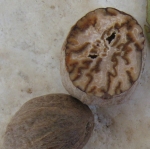The United Nations declared 2016 the International Year of Pulses. What’s a pulse? It’s the dry mature seed of a large number of species in the legume family (Fabaceae): various beans, peas, soybean, chickpeas, lentils, peanuts and other groundnuts. 2016 is days from ending, so it’s high time I get up the Fabaceae diversity post I’ve been meaning to write all year long. This rounds out our year of legume coverage, which included Katherine’s posts on bean anatomy, peanuts, and green beans.

Christmas Lima beans (Phaseolus lunatus), soaking before cooking
One out of every 15 flowering plant (angiosperm) species is a legume, a member of the large plant family Fabaceae (Christenhusz and Byng 2016, LPWG 2013). Boasting around 19,500 species in 750-ish genera (LPWG 2013), the Fabaceae is the third-largest plant family in the world, trailing behind only the orchid (Orchidaceae: 27,800 species) and aster (Asteraceae: 25,040 species) families (Stevens 2016). By my count, people only use about 1% of legume species for food (my list of edible legume species is found here), but that small fraction of species is mighty. People eat and grow legumes because they are nutritional superstars, can be found in almost all terrestrial ecosystems around the world, and uniquely contribute to soil fertility in both wild and agricultural ecosystems. Continue reading






